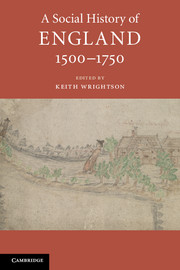Book contents
- Frontmatter
- Contents
- List of Figures
- List of Tables
- List of Contributors
- Acknowledgements
- List of Abbreviations
- Introduction: Framing Early Modern England
- PART I DISCOVERING THE ENGLISH
- PART II CURRENTS OF CHANGE
- 5 Reformations
- 6 Words, Words, Words: Education, Literacy and Print
- 7 Land and People
- 8 Urbanisation
- 9 The People and the Law
- 10 Authority and Protest
- 11 Consumption and Material Culture
- PART III SOCIAL IDENTITIES
- Coda: History, Time and Social Memory
- Further Reading
- Index
11 - Consumption and Material Culture
from PART II - CURRENTS OF CHANGE
Published online by Cambridge University Press: 28 May 2018
- Frontmatter
- Contents
- List of Figures
- List of Tables
- List of Contributors
- Acknowledgements
- List of Abbreviations
- Introduction: Framing Early Modern England
- PART I DISCOVERING THE ENGLISH
- PART II CURRENTS OF CHANGE
- 5 Reformations
- 6 Words, Words, Words: Education, Literacy and Print
- 7 Land and People
- 8 Urbanisation
- 9 The People and the Law
- 10 Authority and Protest
- 11 Consumption and Material Culture
- PART III SOCIAL IDENTITIES
- Coda: History, Time and Social Memory
- Further Reading
- Index
Summary
Introduction
Human cultures generally revolve around food, clothing, shelter, work and worship. Associated activities form the routines of everyday life and entail acts of consumption that involve material artefacts. Material culture is core to creating and sustaining any given group. It rarely remains static over time, but goes through cyclical stages of development. Moreover, it regularly accrues symbolic value. In consequence, it can be understood as a form of communication, but the messages embodied in things may be implicitly coded as well as explicitly stated.
Objects deemed to be special tend to communicate their symbolic value explicitly – in art, court rituals or religious settings – and are often subject to overt rules. More everyday aspects of material culture communicate their significance implicitly, and are more likely to be structured by unspoken social codes, invariably understood by contemporaries but not always commented upon. Nevertheless, it is this configuration of materiality and coded behaviour that gives meaning to material culture as an aspect of social communication. The structuring role of material culture is embedded in the use of utensils, layout of rooms, choice of furnishings, distinctions in dress and experience of the built environment. Interpreting the world of things can provide profound insights into social behaviour and cultural values as well as economic production and exchange. This chapter focuses on the ways in which the consumption of special and everyday material culture was integral to social life in England between 1500 and 1750.
Methodology
The historical study of material culture is best based on two premises. Firstly, material culture needs to be studied as pattern, at a variety of scales. Only by studying the patterns in material culture can we make evidence-based historical claims about the role of materiality in cultural behaviour. Pattern applies not only to particular types of artefact but also to linked sets of artefacts that together constitute a material culture. For example, the material culture of the kitchen, dining table or bed chamber, through to the entire household's materiality including the house itself, were related to other households and formed larger sets. Patterns in defined sets of material culture may be discerned from documentary sources, such as inventories of household goods. Secondly, material culture needs to be interpreted in context. Only by establishing the significance of an artefact can scholars discover the ways in which objects were created and used.
- Type
- Chapter
- Information
- A Social History of England, 1500–1750 , pp. 242 - 266Publisher: Cambridge University PressPrint publication year: 2017



